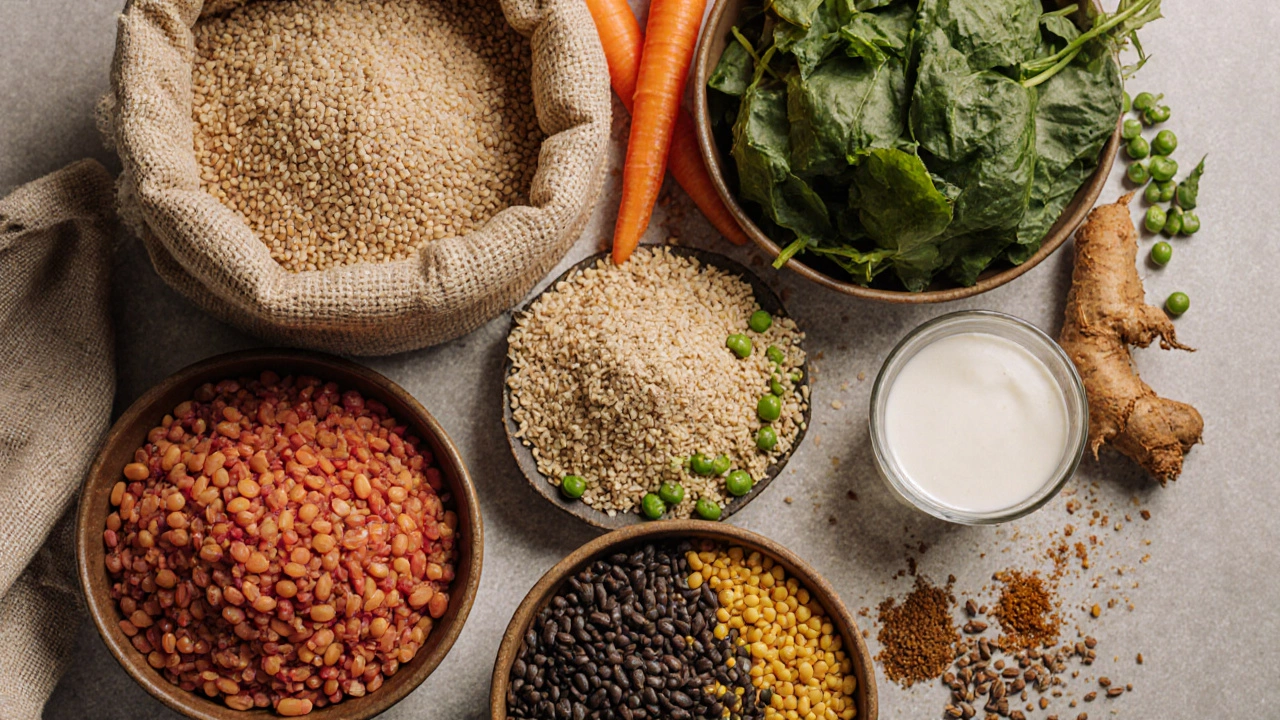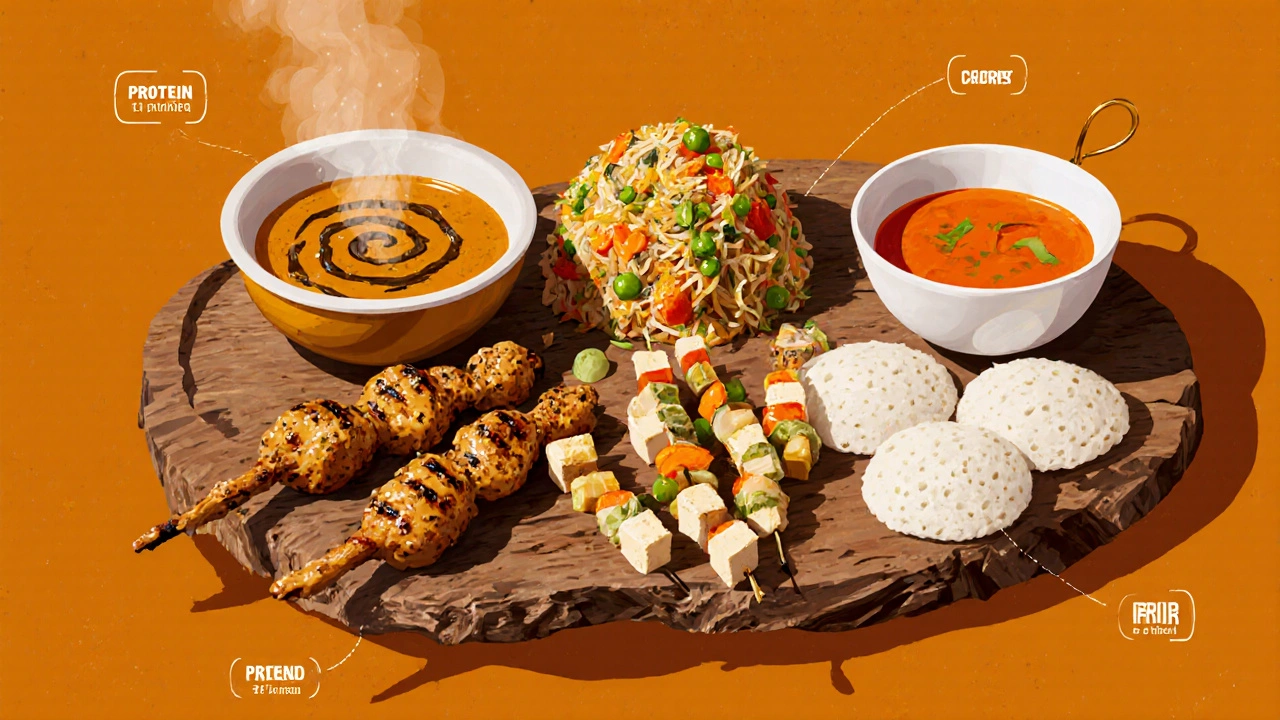Healthiest Indian Foods to Eat: Low‑Calorie, Nutrient‑Rich Picks
 Oct, 2 2025
Oct, 2 2025
Healthy Indian Dish Calculator
Nutritional Breakdown
Dish Details
Select a dish to see detailed information about its nutritional profile and health benefits.
When you hear "Indian food," you might picture buttery butter chicken or deep‑fried samosas. But healthy Indian food is a nutrient‑dense, low‑calorie category of dishes from the Indian subcontinent that support wellness. The cuisine is full of legumes, whole grains, fresh vegetables, and spices that boost metabolism. This guide shows you which dishes rank highest on the health scale, how to pick the right options at restaurants, and simple swaps you can make at home to keep calories in check while still enjoying bold flavors.
Quick Takeaways
- Legume‑based dishes like dal and chana masala top the list for protein and fiber.
- Fermented foods such as idli and dosa provide gut‑friendly probiotics.
- Swap refined wheat roti for ragi or millet flatbreads to boost micronutrients.
- When dining out, request grill instead of fry and ask for sauces on the side.
- Portion control plus a veggie‑rich side can turn a rich curry into a balanced meal.
What Makes Indian Food Healthy?
Indian cooking relies on a handful of core ingredients that, when used wisely, turn meals into nutrition powerhouses:
- Legumes (lentils, chickpeas, mung beans) are rich in plant protein, iron, and soluble fiber, which helps lower cholesterol.
- Whole grains such as brown rice, millets, and whole‑wheat atta provide sustained energy and B‑vitamins.
- Spices like turmeric, cumin, and mustard seeds have anti‑inflammatory and antioxidant properties.
- Fermented batters (idli, dosa) deliver probiotics that aid digestion.
- Fresh vegetables are abundant in Indian recipes, adding vitamins, minerals, and low‑calorie bulk.
The key to health is balance: moderate oil, limit heavy cream, and pair carbs with protein and fiber.
Top Healthiest Indian Dishes
Below are five dishes that consistently score high on nutrition charts while staying true to Indian flavor profiles.
Dal (Lentil Stew)
Dal is a staple across India. Made from split red, yellow, or black lentils, it offers 9g of protein and 8g of fiber per half‑cup serving. The simmering process retains most of the vitamins, especially folate and iron. Adding a teaspoon of mustard seed tempering adds healthy fats without many calories.
Tandoori Chicken (Grilled)
Tandoori chicken gets its smoky flavor from a yogurt‑marinade infused with paprika, cumin, and garlic. A 3‑ounce portion supplies about 26g of lean protein and only 150kcal if cooked on a grill rather than fried. The yogurt adds calcium and probiotics.
Paneer Tikka (Grilled Cottage Cheese)
Paneer tikka uses low‑fat paneer cubes marinated with turmeric, ginger, and a dash of lemon juice. Grilling keeps the calorie count around 180kcal per serving while delivering 14g of protein and calcium. Choose homemade paneer made from skim milk for an extra health boost.
Vegetable Biryani (Brown Rice)
Vegetable biryani combines brown basmati rice, mixed veggies (carrots, peas, beans), and aromatic spices. A cup packs roughly 220kcal, 5g of protein, and 4g of fiber. The inclusion of turmeric and cinnamon adds anti‑inflammatory compounds.
Idli with Sambar
Idli are steamed rice‑lentil cakes. Two medium idlis provide only 80kcal, are low in fat, and contain a modest amount of protein. Paired with sambar-a spiced lentil‑vegetable broth-you get an extra 3g of protein and plenty of micronutrients like vitaminC from the vegetables.
Nutrition Snapshot
| Dish | Calories | Protein (g) | Fiber (g) | Key Nutrient |
|---|---|---|---|---|
| Dal | 180 | 9 | 8 | Iron & Folate |
| Tandoori Chicken | 150 | 26 | 0 | Calcium (from yogurt) |
| Paneer Tikka | 180 | 14 | 0 | Calcium |
| Vegetable Biryani | 220 | 5 | 4 | Magnesium (brown rice) |
| Idli + Sambar | 200 | 7 | 3 | VitaminC (veg broth) |

How to Choose Healthy Options When Eating Out
Restaurant menus can be intimidating, but a few quick checks keep you on track:
- Look for grilling, baking, or steaming keywords. Dishes labeled “tandoori”, “bhuna” or “roasted” usually use less oil.
- Ask for sauces and gravies on the side. This lets you control how much you pour over the plate.
- Swap naan for whole‑wheat roti or millet roti. The latter adds calcium and fiber.
- Prioritize dishes with visible vegetables-spinach saag, bhindi masala, or mixed‑veg curry.
- Watch portion sizes. A typical restaurant serving can be double a home‑cooked portion. Split the plate and save half for later.
Simple Swaps to Lighten Classic Favorites
You don’t have to give up beloved recipes. Small tweaks can slash calories while preserving taste.
- Butter chicken → Yogurt‑based sauce. Replace cream with blended cashew‑yogurt mixture for similar richness.
- Deep‑fried samosa → Baked phyllo parcels. Use minimal oil and add a sprinkle of chaat masala for crunch.
- White rice → Quinoa or cauliflower rice. Both supply extra protein or cut carbs dramatically.
- Ghee‑rich dal → Light oil tempering. One teaspoon of mustard oil is enough for flavor.
- Paneer → Tofu. Tofu absorbs marinades well and drops saturated fat.
Sample One‑Day Healthy Indian Meal Plan
Use the dishes above to build a balanced day that stays under 1,800kcal.
- Breakfast: Two steamed idlis with a cup of sambar (≈200kcal).
- Mid‑morning snack: A handful of roasted chickpeas (≈120kcal).
- Lunch: One cup of dal, half a cup of brown rice, and a side of cucumber‑mint raita (≈450kcal).
- Afternoon tea: Fresh coconut water and a slice of papaya (≈80kcal).
- Dinner: Grilled tandoori chicken (3oz) with a small serving of vegetable biryani and a mixed‑veg salad dressed with lemon‑olive oil (≈550kcal).
- Evening snack (optional): A cup of low‑fat curd with a pinch of roasted cumin powder (≈100kcal).
This plan delivers about 1,500kcal, 70g protein, and 25g fiber-perfect for weight maintenance and gut health.
Frequently Asked Questions
Can Indian food be part of a keto diet?
Yes. Focus on high‑fat, low‑carb dishes like paneer tikka, butter‑free coconut curries, and cauliflower‑based “rice” or “naan”. Avoid lentils and grains, which are higher in carbs.
Is tandoori chicken truly low‑calorie?
When grilled without added butter, a 3‑ounce serving is around 150kcal and packs 26g of protein, making it a lean option compared to fried chicken.
How much oil is too much in Indian cooking?
A good rule of thumb is ≤1teaspoon (5ml) per serving for tempering. If a recipe calls for a cup of oil, halve it and finish cooking with a splash of water or broth.
Are fermented foods like idli good for digestion?
Yes. The fermentation process produces probiotics that support a healthy gut microbiome, aid nutrient absorption, and may reduce bloating.
Can I replace regular roti with millet roti for extra nutrients?
Absolutely. Millet (like ragi or jowar) adds calcium, iron, and fiber while keeping the carb load moderate. It also gives a pleasant earthy flavor.
Next Steps
Start by swapping one weekly dinner for a dish from the "Top Healthiest Indian Dishes" list. Track how you feel after a few weeks-energy levels often rise when you add more fiber and protein. If you eat out frequently, keep the quick‑choice checklist handy and ask the server for lighter preparation methods. Finally, experiment with the simple swaps in your favorite recipes; you’ll be surprised how little you need to change to make a big difference.
